Kibera Slum: When Kindness Kills Development
By: Linh Vo
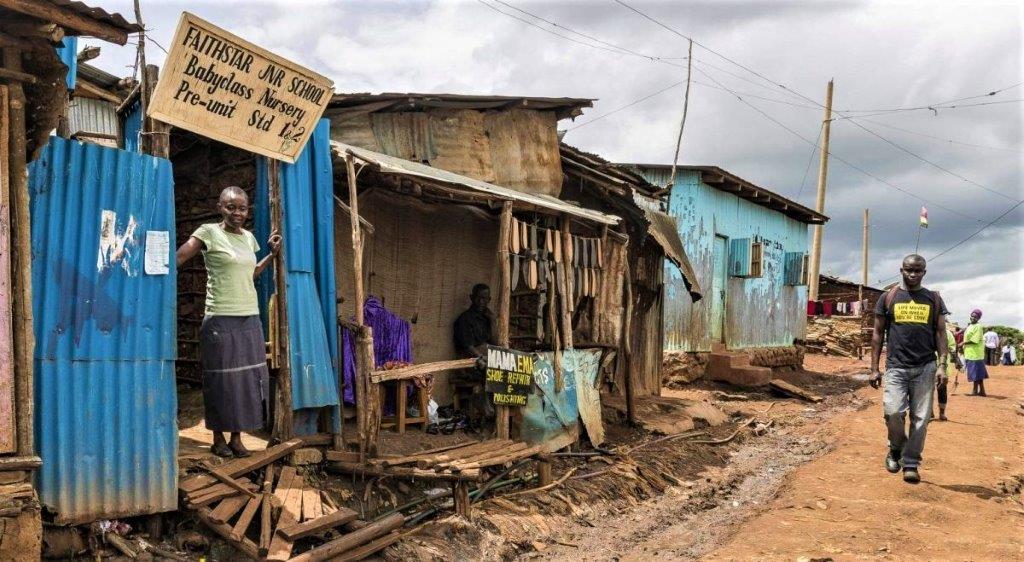 Photo: Wikimedia Commons (Ninaras)
Photo: Wikimedia Commons (Ninaras)
“We are so busy at helping and forget that, sometimes, we need to stop and look. Are we bringing any change? Are more than 500 NGOs trying to bring any change? If yes, where are the impacts?” – Asha Jaffar Harun.
It was exhausting after a while being in and out Kibera to interview people. My friend, Roger, asked me the best experience I had. I told him: “You know, my dream has come true. I am now a white person.” People in the slum called me “mzungu,” (which means “a white person”) even though my skin is yellow, and I am from Asia.
The first day I showed up at Cheery Education Centre to help with a fundraising project, Emily, the head teacher, asked me how I got there. “By walking,” I said. “You walked? Are you kidding me? You were not scared at all?”
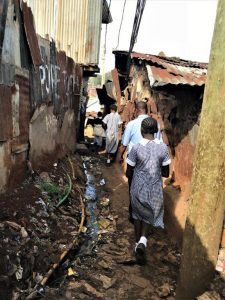
Scared? I chuckled. I don’t scare easily after backpacking through many countries alone for two years, not to mention nearly dying in an avalanche in Nepal.
Being white is something I had always wished for. Unfortunately, I soon realized that being viewed as white in Kibera meant being considered as a potential source of money. Nothing more, nothing less. I was just a foreigner in Kibera slum.
A lady in the Toi market asked me when I told her I am doing a research paper about Kibera: “So, are you bringing money to us?” Another one cried immediately and started telling the story of her life and how hard it is for her to be a single mom.
The lady’s face was down when I left without giving her anything. I felt guilty, though. I could have given her some dollars or bought her something to eat. But I did not. As long as I keep doing that, I teach them the culture of being beggars, and when the next foreigner comes, they will beg him or her for something. It is the same mistake that NGOs are making by giving locals a “sitting allowance” (money to to encourage them to attend workshops). The next time, if an NGO does not give money, no one comes.
511 NGOs in the slum of 2.5 square kilometers
In the 1990s, the donor community lost faith in Kenya because of the corrupt regime of President Moi. They started giving money directly to NGOs. According to Global Humanitarian Assistance, in 2016, Kenya received $2.4 billion in official development assistance (with 801 million from the USA) [1], making it one of the world’s largest recipients of international aid. Each year, NGOs received hundreds of millions to be used on development projects throughout the country. Kibera has been the most attractive place for NGOs: first, it is easy to ask for money from donors for the biggest slum in Africa by population. According to some NGOs, Kibera is home to 1 million or more inhabitants. Second, it seems easier to deal with problems since the slum is only about 2.5 square kilometers [2]. The 2009 Kenya Population and Housing Census shows that Kibera has just 194,269 residents [3]. Other estimates are higher depending on which slums are included in defining the area.
Despite all the money that has been pouring into Kibera, life is no better after almost 30 years: people still live in shanties with nothing to eat, the youth are still unemployed and unemployable; the “flying toilet” is still common; trash is everywhere; there is a shortage of water; there is no money for school uniforms or textbooks; people still live on less than a dollar per day.
In 2000, there were over 200 NGOs located in Kibera [4]. They were supposed to lift people out of poverty. The number has likely grown in the past decade although the exact number isn’t known. According to Jane Muya, a social worker who worked in Kibera for a couple of years before changing jobs, when she was there there were 511 NGOs and CBOs (Community-Based Organization).
The NGO Coordination Board in Kenya cited that there are around 12,000 expat NGO workers in Kenya working on issues that range from human rights to maternal health to conservation. “These organizations are not contributing as much to the country as they should be. They fail to transfer jobs to local workers, and instead stay on in Kenya as lifelong “career expats”, the NGO Board reported [5].
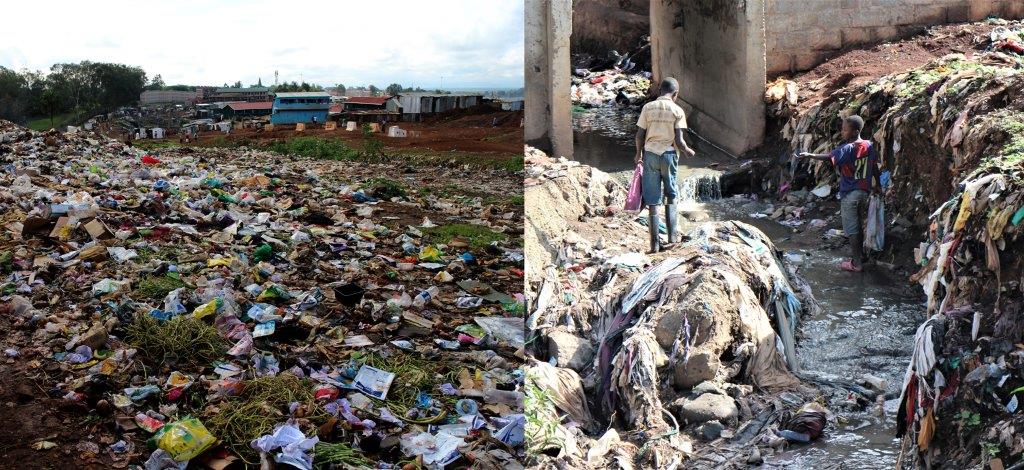 Kibera is still filled with trash after so many years. Photo credit: Linh Vo
Kibera is still filled with trash after so many years. Photo credit: Linh Vo
“Kindness is killing us.”
The day after I arrived in Nairobi, I had an appointment with Asha Harun, a journalist who was born and raised in Kibera slum. She still lives there. Asha has publicly criticized NGOs and has been bothered by some NGOs after her remarks. Having a cup of tea, she told me, “You know, kindness is killing us. The world wants to help, and the organizations come here, sending their proposals under the name of ending poverty. However, we are being commercialized rather than being “helped.” Kibera is just a place for people to fill their bank accounts, and a lot of organizations do not know the importance of involving people in their work. How do you end poverty without involving the poor who you are trying to help?”
Our conversation went on and on, and Asha, in the end, told me, “NGOs feed us a little to prove that they are doing something. But they want to keep us poor to maintain their jobs and their organizations. The best way to help may be to ask them out and leave us alone so that we can find a way to survive ourselves.”
It was a sad statement, but I understand her point. Every day as I walked to the slum, I saw groups of men standing on the street doing nothing while women were doing cleaning jobs for rich people to get some shillings to feed their children. Many women in Kibera are single moms. If visitors happen to be in the slum at night, they will see those women get up at 3 am, cook something for their children and then start walking to the rich area to work as cleaners. It takes them 1 or 2 hours to walk, and they have to make sure that they arrive at 6 or 7 am before the rich people leave for work. To me, those women are strong enough, independent enough, and know well enough how to control their own lives. Unfortunately, books and school tell us that women are vulnerable, and therefore, we should empower them. That is why most NGOs come and try to organize workshops to empower women. But in Kibera, I believe NGOs should be focusing more on creating employment opportunities for men.
It is a surprise to me that after interviewing numerous people, I didn’t hear anything good about NGOs. Trust in NGOs seems to be dead in Kibera. There is a popular comedy series called “The Samaritans,”[6] which pokes fun at the ineffectiveness of NGOs. Many of the Kenyan people I met are big fans. They seemto believe that a large amount of NGO funds ends up financing administration costs, and is used to pay for consultants, lawyers, and hundreds of “experts” who are waiting for their turn at the trough of “sorrow dollars.”
NGOs combine poverty with inability
Although there are many claims that NGOs are making money by selling the poverty image, I believe that some of them are trying to help and I wanted to hear a different view. Esther, my local assistant as well as a staff of Jamii Bora Trust, helped set up a meeting with Mrs. Ingrid Munro. Ingrid Munro is the founder of the Jamii Bora Trust, the biggest microfinance organization in Kenya. The words “jamii bora” mean “good families.”
“The most common mistake NGOs are doing is that they combine poverty with inability. I believe that all the poor have their own talents. The problem is they lack the opportunities, and that is why they cannot use their talents,” Mrs. Ingrid shared with me.
Perhaps, that was the reason why Mrs. Ingrid started her organization to provide micro loans to the poor. She first picked 50 women, beggars, loaning them twice as much as they agreed to save. The loans start with 250 – 5000 shillings (around $2.50 – $50). The loans get larger when their credits go up. But some people could not even repay $2. “I approved a loan of 700 shillings for a guy. But after seven years, he still cannot pay it back,” Esther told me.
“So, all NGOs are bad?” I asked Jane Muya, the social worker. “No, they are trying to help at some point. But kindness is not always good, you know. Some NGOs give people food; some provide water, some donate clothes. It is okay to help at the beginning. But if year after year, they keep doing that, it will create a dependency syndrome. You will see one family benefits from different things from different NGOs. They do not want to change because if they change, they are afraid of stop receiving things for free. You will see there is a certain group of people who comes to any NGO’s workshops because NGOs give a “sitting allowance.” They come to enjoy free lunch and get some dollars for the day. But when they get back home after the workshop, they forget everything in the workshop. They did not come for knowledge at the beginning. How can you ask them to remember in the end?”
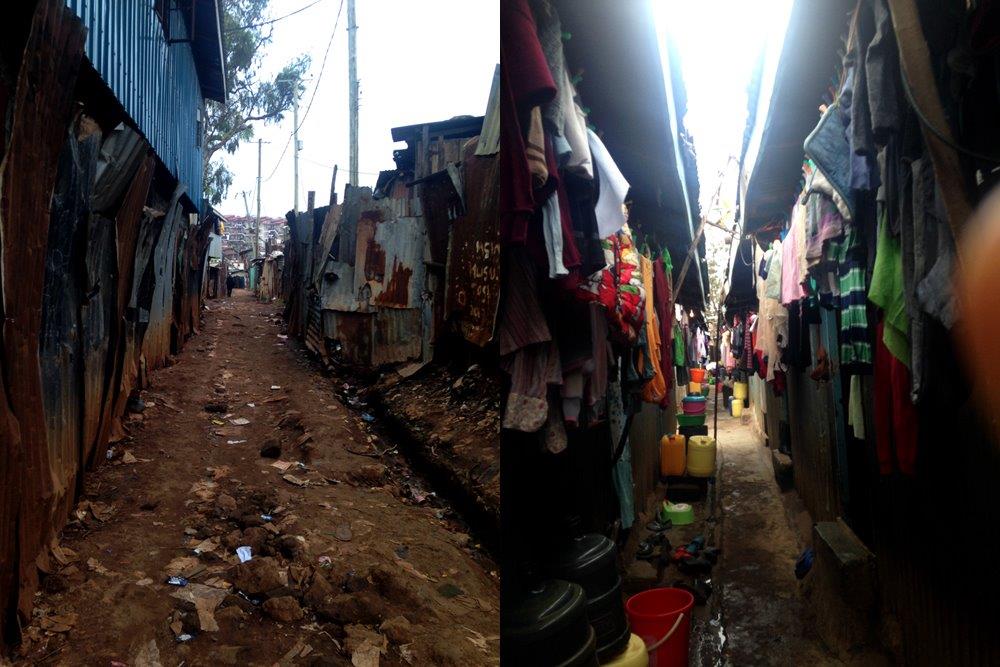 Inside the slum. Photo credit: Linh Vo
Inside the slum. Photo credit: Linh Vo
NGOs forget to answer the question: “What is next?”
On a quiet day at Cheery Education Centre, Jairus, the school director, and I had chats. “NGOs forget to answer the question: what is next? They create something that they believe is good for the poor, then they leave the poor there, without showing the poor the next steps,” Jairus told me.
What Jairus said kind of made sense to me. Take the Kenya Slum Upgrading project [7]as an example. The program started in Kibera in 2003 and was sponsored by the UN-Habitat and the Kenya Government. They wanted to provide the slum dwellers with nicer apartments at low costs. But people without a job, cannot afford to pay the rent because everything in the slum is cheaper. As a result, some individuals who were lucky enough to get an entire house usually ended up using only one room and subletting the other rooms to make money. Worse than that, some individuals rented out the entire house and moved back to the slum. The project failed because the sponsors just cared about providing houses but forgot to answer the next question: “how can the slum dwellers make money to pay for the rent?”
“Some other NGOs try to teach people skills such as tailoring. They provide the poor some basic allowance so that the poor are motivated to attend the training classes. A month or two later, they give the poor certificates and tell them to get out there and survive. But the poor do not need a certificate. They need jobs. Without jobs, all the skills that the poor learned become useless,” Jairus continued. “You know, the poor then get back, have nothing to do and get into drugs and alcohol. They believe that when they get high, they will forget something. They do not know that the next day when they get up, the problem is still there.”
The poor do not need certificates. They need jobs and need help to bring their products to the market.
While trying to provide humanitarian assistance, giving the poor certificates for pictures that make it look good in report papers, most NGOs ignore unemployment. They say that is the government’s job. There are very few career centers that help people seek jobs, and most of them just provide household jobs such as maids and cleaners. Kibera residents still seek jobs in a traditional way.
It is a serious problem that the majority of men in Kibera are jobless and are a burden for the family and the society while in other countries men are the primary source of income. “Those men are willing to take any job they can. But it is hard for them since there is no job market here,” Esther told me. “To get a job in a factory, they have to walk for 3 hours to the industry area since the bus will cost them money. They have to be strong enough to walk. And as soon as they arrive there, they have to fight with thousands of other men who come from the other parts of the city. If they are lucky enough, they get hired for a day. If not, they get back in hungry.”
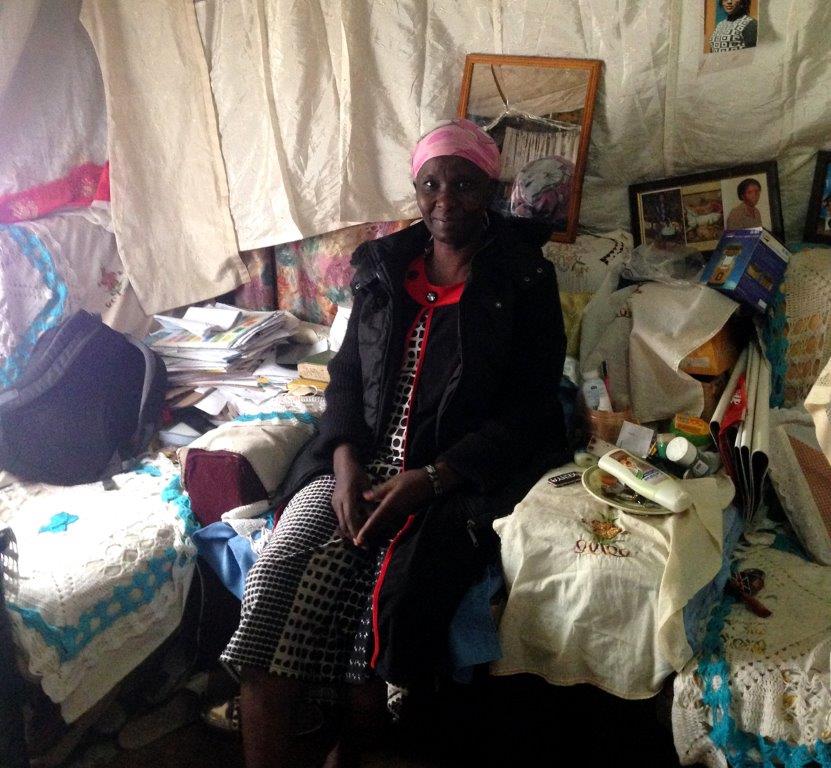 Esther in her small shack in Kibera slum. Photo credit: Linh Vo
Esther in her small shack in Kibera slum. Photo credit: Linh Vo
According to the latest 2017 Human Development Index, Kenya’s rate of unemployment is equal to neighboring Ethiopia and Rwanda combined [8]. In Kibera, the unemployment rate is at 50% [9].
The problem is getting worse since high costs (such as energy and taxes) and cheap imports from China have flooded the local market, make it hard for local companies to compete profitably. Since most manufacturing companies can’t keep up, they either scale down operations or shut down. About 2.2 million small enterprises have closed shop over the last five years, underlining the tough challenges that the local business climate poses for investors [10].
Kenya Association of Manufacturers (KAM) quarterly research showed slightly more than three-quarters of manufacturers surveyed did not plan to hire new staff in the next six months. Some 43 percent of the firms said they plan to retain their existing workforce, while 33 percent are looking at trimming staff to protect profit margins [11].
Not only jobless people are hurting, residents who have jobs in Kibera are also suffering.
Abzeid, my local guide, took me to visit a craft shop where people turned animal bones into necklaces and jewelry. The business is considered innovative by many locals since it helps turn waste into something useful. The problem is that since everything is done by hand, it is a long process for the workers to get to the final products. I bought a keychain to support them.
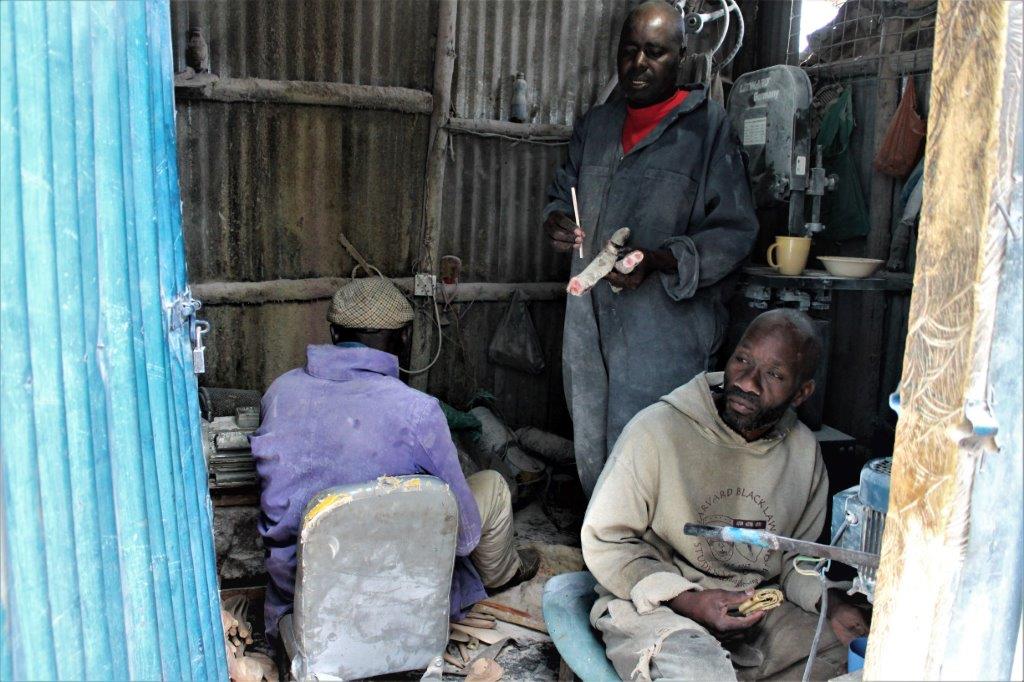 Workers in the small shack that turns animal bones into jewelry. Photo credit: Linh Vo
Workers in the small shack that turns animal bones into jewelry. Photo credit: Linh Vo
Abzeid asked me if I saw the shop as a good business. “It is a kind business, but not a good business. I would not have bought the keychain unless I was doing charity,” I told Abzeid. “Why?”, Abzeid kept asking. “Five dollars for a keychain is expensive,” I answered. “I can get a keychain in Vietnam for 50 cents. So if those guys want to sell more, they need to more skillful, and they should lower the price if they want to bring their products to the general market.”
Attracting business for the products here is a challenge. The Toi market is huge and is located in the heart of Kibera. It is supposed to create businesses and jobs for people in the slum. But after visiting it for a few times, I realized that the majority of the customers are slum residents. Rich people are afraid of the slum. It is not considered safe and clean. And since all the products in the Toi market are second hand (even socks and underwear) and imported from China, it only attracts the poor who do not have money. The money just goes around the poor circle. A chapati which is sold for $1 or $2 in other areas is only 10 cents in Kibera because it is for the poor. As a result, it is hard for Kibera residents to make good profits since their products barely reach the middle and upper-income people as well as the markets outside of Kibera.
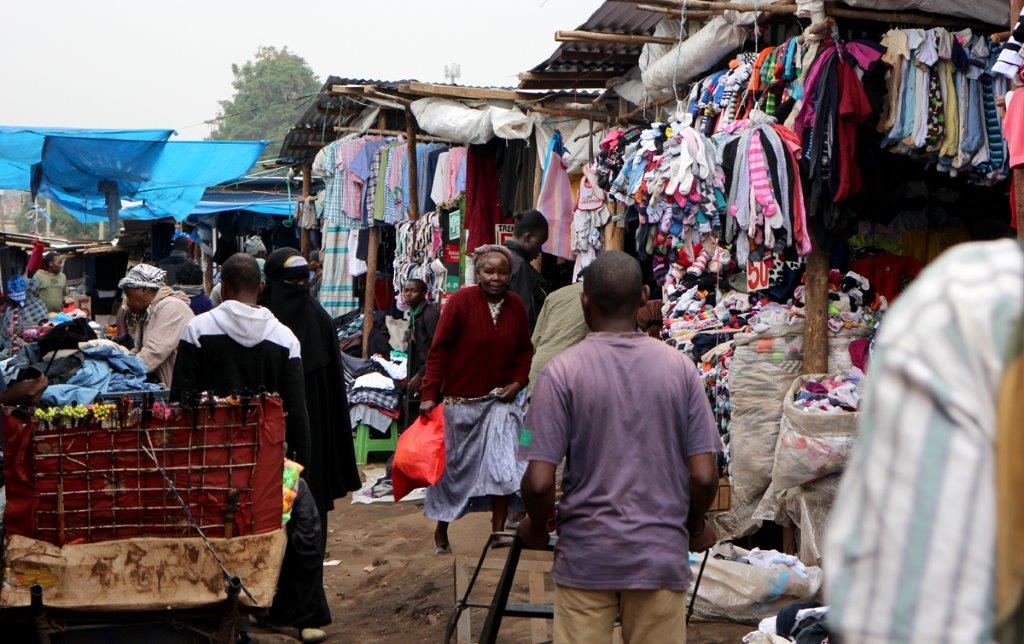 The Toi market located in the heart of Kibera slum, mostly sells secondhand products. Photo credit: Linh Vo
The Toi market located in the heart of Kibera slum, mostly sells secondhand products. Photo credit: Linh Vo
As I write this paper, I started watching the “The Samaritans” show. Mary Anne Karani, who is a fan of the show as well as a local NGO staff, shared her comments in an article: “The main character speaks in a typical NGO language, which is so much jargon but basically saying nothing in particular. It reflects the reality of NGOs like us. We spend the whole day in meetings in five-star hotels talking about big things like capacity building, empowering, poverty alleviation, and so on. It all sounds good on the tongue and looks good on paper, but that is where it stops.”[12]
Her comments remind me of the day I was sitting in the poverty reduction class. We all used big words like capacity building, resource mobilization, bridging the gap, and so on. We all looked smart. But after getting out of the class, I could not remember any specific things. My professor told me that she is glad that I am spending time doing micro work, talking to local residents to understand the root causes of the ongoing misery. I wonder, without doing micro work, how can policymakers know the challenges that the poor face? How can they design suitable policies and projects to help them? But it is true that we do have people sitting in the big buildings in DC creating plans and proposals to help the poor without going to the fields and talk to them, isn’t it?
I was only in Kibera for about six weeks, which is definitely not enough time to fully understand all of the factors contributing to poverty there. I am grateful that my Rotary fellowship is giving me the opportunity to learn how to do development in a more thoughtful way.
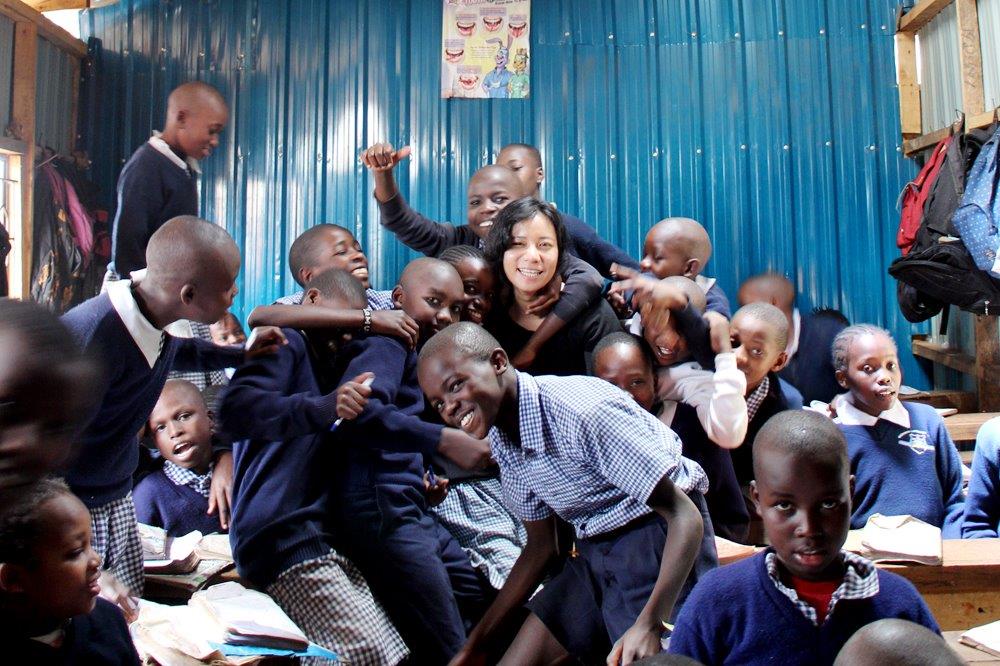 Myself with children at Cheery Education Centre, Kibera.
Myself with children at Cheery Education Centre, Kibera.
.
________________________________
“Flying toilet”: people in the slum use plastic bags for defecation then thrown them into ditches, on the roadside, or simply as far away as
possible.
________________________________
References:
[1] http://data.devinit.org/country/kenya[2] https://www.lunchbowl.org/the-kibera.html
[3] “Myth shattered: Kibera numbers fail to add up”, Muchiri Karanja, September 2010, Daily Nation.
[4] Barcott, Rye. 2000. “The Kibera Slum, Kenya: Do NGOs Help?” Anthropology News 41 (9): 13.
[5] “Kenya is pressuring thousands of expat NGO workers and volunteers to go home”, Lily Kuo, July 2016, Quartz Africa.
[6] “Kenya’s first mockumentary takes on the NGO world”, Caitlin L Chandler, 2014.
[7] “Kibera upgrading project full of contradictions”, Lukorito W Jones, June 2015, Daily Nation.
[8] http://hdr.undp.org/en/composite/HDI
[9] https://www.kibera.org.uk/facts-info/
[10] “Cheap imports, high costs: Why many businesses are closing shop”,Brian Ngugi, December 2016, Daily Nation.
[11] “Grim outlook as industries freeze hiring, signal layoffs”, Salaton Njau, May 2019, Business Daily.
[12] “Casting Call for Kenya’s ‘Briefcase’ NGOs”, Miriam Gathigah, February 2014, IPS News.